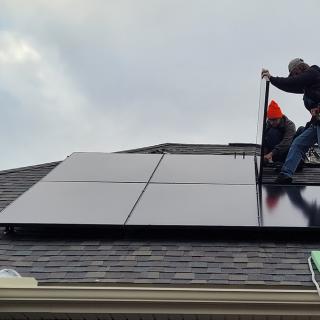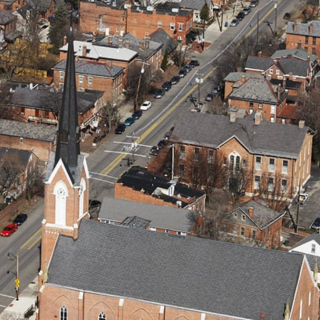Advertisement
When the relatively unheard of IQAir released its annual “World Air Quality” report earlier this year, it found the “most polluted major U.S. city was Columbus, Ohio.”
Equally alarming and unbecoming is how IQAir said Columbus has a high concentration of PM 2.5, described as some of the worst inhalable particles, which can cause depressed lung function and premature death.
PM 2.5 (particle matter) is mostly created by burning fossil fuels. Some claim automobile-centric Columbus “smells bad” around 9am, just after rush hour. But worse air quality than Los Angeles?
“Usually, Los Angeles is up there. But Columbus beat Los Angeles,” said IQAir’s CEO of North America Glory Dolphin Hammes to WOSU back in March.
Both the Mid-Ohio Regional Planning Commission and the Ohio EPA told WOSU the methodology IQAir followed is providing inaccurate data because some of their air sensors are not up to federal EPA standards.
Nevertheless, Columbus is besieged, like many a major city, by gas-powered cars and diesel-powered (monster) pick-ups trucks. Semis are pouring in and out, mostly via 70 West and East, as Rickenbacker airfield has helped turned Columbus into one of the largest trade hubs on the planet.
A grassroots push for greater use of bikes and public transit is ongoing, but reality says most Central Ohioans won’t be giving up their car anytime soon. It’s too great a lifestyle change.
All is not lost in the haze, though. One long-term City of Columbus plan now underway could be a potential solution for too much PM 2.5.
Columbus Urban Forestry Master Plan to the rescue(?)
Rebecca Hunley of Franklinton has been keeping a keen eye on the trees like a curious owl. She believes Columbus needs more, as other community members and office holders do. And depending on where you live, a lot more. Especially during rising temperatures, increasing pollution and out-of-control development.
“Franklinton is a tree desert. A hot spot inside a hot spot city in Ohio,” Hunley said to the Free Press.
Trees, as many know, absorb air pollution and carbon, and create oxygen. They prevent heat-related deaths in urban heat islands. They soak up flood water and muffle urban noise.
Recently, a “house flipper” purchased the most notable home in Hunley’s Franklinton neighborhood.
“The flipper cut down the oldest tree in front of the oldest house on the block. In other cities that would not have been permitted especially in a hot spot neighborhood,” she says.
According to the Tree Equity Score, a nonprofit supported by the likes of Microsoft, one Franklinton neighborhood ranks 570th out of 643 Columbus “block groups”. This neighborhood’s canopy cover is 14 percent yet ideally should be around 40 percent. Nearly 80 percent of this (non) neck of the woods is defined as “living in poverty”. The Tree Equity Score also shows an average surface temperature of 86 degrees.
Hunley is also keeping a close eye on a new City policy moving forward to plant more trees. A policy many residents may not be aware of – the Columbus Urban Forestry Master Plan or “UFMP.” The first ever citywide strategic plan to invest long-term in Columbus trees over the next decade.
The UFMP wants to double Columbus’s tree canopy by 2050, and provide better protection for existing trees by amending and adding to the city code. The City-affiliated Green Columbus, a nonprofit, and Columbus Recreation and Parks have spent three years putting the UFMP in motion. (Green Columbus did not return requests for an interview after first saying they would).
What UFPM found initially was Columbus lags far behind other similar sized cities. Columbus’s canopy cover is at 22 percent compared to 40 percent for both Cincinnati and Pittsburgh. Columbus also ranks in the top-10 of the most intense summer urban heat islands when compared to nearby rural communities.
In 2015, then-Mayor Mike Coleman enlisted the help of 20 nonprofits to plant 300,000 medium-sized trees throughout the city by 2020. Increasing Columbus’s canopy from 22 percent to possibly 31 percent. Eight years later it is still at 22 percent, as previously mentioned.
“They are way behind,” deadpans Hunley who’s followed Coleman’s plan.
The majority of the Columbus canopy is on private land, close to 70 percent. Public trees are along streets, in public parks, and on all city properties. An interesting sidenote is how the City maintains an inventory of all public trees. Last decade they found Columbus public trees are “generally small, with 62 percent being only being only 0"-8" in diameter. The ideal distribution for trees of this size is 40 percent.”
Private trees are not regulated citywide in Columbus. Whether during development or after a development is completed. This is uncommon for a city of Columbus’s size, says Hunley.
But regulations are on their way. This year possibly, and the public will have a chance to weigh in on these drafts, according to the UFMP.
Last winter and open for two months, the UFPM made a call for public input for a future “Public Tree Code Revision project.” Over 50 percent of the 200-plus submissions wanted to know “What to Plant,” while the two highest concerns for local trees were “Need to Protect Trees” (33 percent) and “Development” (26 percent).
The best submissions were the written ones. A rare chance for the residents of Columbus to chip in with their expertise. Directed at a local government which might as well be the dingbat on TikTok who tried to cut a tree down himself to only watch it crash into his house:
- “We are rapidly losing existing trees. Planting trees won’t matter today. City needs to track tree removal through development at plan review to understand real impacts of tree loss to the urban canopy.”
- “Fix the giant loophole allowing developers to use a variance to get out of putting money into the tree fund.”
- “Pass a tree ordinance requiring tree replacement, like many other cities have done. Make trees a part of the developing process, instead of an inconvenient afterthought.”
- “Require new developments to not only provide a minimum tree number, but also require adequate soil volume for those trees.”
- “The electric company could stop cutting down and killing all of the established trees. They killed a 150-year-old maple in my backyard and my oak tree out front.”
- “Keep our trees, keep the green spaces, keep parks. Stop cutting down trees.”
- “First and foremost – preserve the canopy that we already have!”
- “City street and utility maintenance crews do not prioritize trees when replacing sidewalks and clearing around overhead power lines.”
- “Like many cities, our city leaders can require developers to set aside green space whether for new builds or renovation spaces.”
- “Protect old trees that are doing well. They are super carbon sequesters.”
- “Strengthen city codes and enforce them with fewer variances.”



